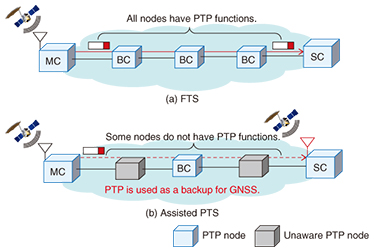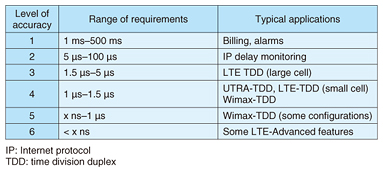 |
|||||||||
|
|
|||||||||
|
Global Standardization Activities Vol. 14, No. 2, pp. 47–53, Feb. 2016. https://doi.org/10.53829/ntr201602gls Overview of Network Synchronization Technology Standardization in ITU-TAbstractNetwork synchronization technologies are fundamental to telecommunications network services around the world. They are standardized internationally by the Telecommunication Standardization Sector of the International Telecommunication Union, Study Group 15. In this article, we present an overview of time and phase synchronization technologies that have been gaining attention in recent years and explain how these technologies can be achieved. We also introduce the initiatives being implemented for their international standardization and review the other topics being discussed for future standardization. Keywords: network synchronization, PTP, ITU-T SG15 1. IntroductionWith telephone or leased line network services using time division multiplexing (TDM) technologies such as synchronous optical network (SONET)/synchronous digital hierarchy (SDH) or asynchronous transfer mode (ATM), it has conventionally been necessary to match clock frequencies between network systems, or in other words, to synchronize networks, so that data can be transmitted and received. Synchronization technologies are fundamental network service technologies that are widely used by telecommunications carriers around the world. The standardization of these technologies has been ongoing for many years in international organizations including the Telecommunication Standardization Sector of the International Telecommunication Union (ITU-T). The NTT Group has made proactive contributions to international standardization efforts related to synchronization while developing equipment to generate and distribute high-quality clock frequencies. Many telecommunications carriers are facing difficulties nowadays due to the aging of TDM network equipment and maintenance cost increases. Nevertheless, packet transport technologies have been developed that are cheaper than TDM technologies but provide a similar level of quality, which has accelerated the movement to replace TDM networks [1]. Synchronous Ethernet technologies have been developed to distribute clock frequencies on packet networks to establish network synchronization; these technologies were standardized internationally by ITU-T in 2008 [2]. Furthermore, in addition to requirements for frequency synchronization between equipment, the emergence in recent years of applications requiring time and phase synchronization with absolute time means that the areas in which synchronization technologies are applied are expanding. In addition to the mobile field, time and phase synchronization technologies are anticipated for uses such as matching timing with electricity storage and supply in the energy sector and high frequency trading in the financial and securities fields. 2. Technologies achieving network synchronizationThere are mainly two classes of technology that enable synchronization of time and phase (Fig. 1). The first entails the acquisition of standardized time data via radio signals received from global navigation satellite systems (GNSSs) such as the Global Positioning System (GPS). However, there are concerns about degradation in GNSS reception sensitivity due to constraints on antenna installation because of obstacles such as buildings in urban areas, the effects of radio interference, and solar winds or unfavorable weather conditions.
The other class consists of methods that entail synchronization via a network by using a protocol such as Network Time Protocol (NTP) or Precision Time Protocol (PTP). With NTP, clients request time synchronization from an NTP server that maintains a time standard. The clients perform time and phase synchronization in consideration of the time taken for a response to a request and the time between the server and the client. With PTP, devices that perform synchronization take on the roles of master and slave. These devices mutually exchange PTP packets appended with time data (t1 to t4), as shown in Fig. 2. Based on the packet transmission and reception time, slave devices calculate the delay between devices and the time offset between the master and slave so that the slave can match its time with the master.
NTP uses a timestamp in the application layer and has synchronization accuracy to 1 ms. In contrast, PTP offers high-precision time and phase synchronization to 1 μs or lower with a hardware timestamp function and compensation for transmission path delay. In addition to the time and phase synchronization characteristics given in Table 1, PTP is also characterized by its ability to synchronize frequency by calculating the transmission interval from the PTP packet master as well as the reception interval at the slave.
Thus, PTP’s superiority over NTP in synchronization precision and scope of applications means that PTP technologies are gaining attention in a wide range of business fields requiring high-precision time and phase synchronization, while PTP defined by IEEE (Institute of Electrical and Electronics Engineers) is being standardized by ITU-T for use in the telecommunications field. However, a number of issues must be solved in order to achieve high-precision time and phase synchronization with PTP on a telecom network. For example, if wavelength division multiplexing (WDM) equipment or multiplex equipment that does not support PTP is used, uplink and downlink delay asymmetry must be corrected in the PTP offset calculation. In addition, network congestion can cause packet delay fluctuation or PTP packet loss, which can seriously affect synchronization precision. ITU-T is actively discussing problems that can have particularly serious impacts, and NTT has proposed delay asymmetry compensation methods to ITU-T, which were specified as recommendations in standardization documentation in 2014. 3. ITU-T recommendation systems and standardization trends regarding network synchronizationITU-T discusses numerous issues including network synchronization precision, requirements for configuring networks, profiles, and testing and measurement methods for telecommunications. Through standardization, ITU-T prescribes the quality for synchronization applications to achieve interoperability between telecommunications providers and interconnectivity between equipment. The ITU-T standardization recommendation system related to synchronization is shown in Fig. 3. Synchronization standardization recommendations are mainly for synchronous Ethernet, or are roughly divided into PTP frequency synchronization with the G.826x series recommendations, and time and phase synchronization with the G.827x series recommendations, where standardization of the former is almost complete. Standardization of the latter has been finalized and covers the requirements and limitations for configuring synchronized networks centered on time and phase synchronization using PTP and related equipment and network architecture. Currently, however, with new demands from end users for time and phase synchronization, there is a need to amend existing recommendations or create new ones, which has spurred discussions among carriers and system/device vendors around the world.
4. Diversification of synchronous network structuresITU-T is targeting a number of profiles to achieve network synchronization. One of these, shown in Fig. 4(a), is called full timing support (FTS) and has already been standardized as G.8275.1. FTS uses a master clock supplied with time data from GNSS, and it is a profile in which time is distributed to end applications via networks on which all devices have PTP functions. In contrast to this, a profile called partial timing support (PTS), in which only some devices on the network support PTP, has also been proposed. PTS has been targeted for the G.8275.2 standards recommendations for 2016. Many issues remain such as defining switching actions that address degradation of time and phase synchronization quality on packet networks with PTS; hence, discussions are ongoing. In particular, assisted PTS used in conjunction with GNSS synchronization is attracting attention, as shown in Fig. 4(b).
Behind this lie differences in the status of synchronization equipment implementation and in the thinking about the network structures of different carriers. With FTS, carriers building new synchronous packet networks can build them so they are compliant with standards, whereas carriers that have already deployed packet equipment that does not support PTP will need to set up new equipment, replace equipment, or add functions to achieve FTS. These carriers would like to be able to set up time and phase synchronization with assisted PTS used in conjunction with GNSS antennas installed only where high-precision synchronization is required. Thus, to implement time and phase synchronization in the future, carriers will have to select the appropriate FTS or PTS profile to suit their network structures. This will require detailed consideration of various factors such as reliability and operability, including issues such as new PTP equipment deployment and comparative costs of installing antennas for synchronization with GNSS. 5. High-precision time and phase synchronizationA future standardization issue for ITU-T is to make synchronization more precise. Therefore, ITU-T has defined six levels of precision for time and phase synchronization, as listed in Table 2. Current ITU-T recommendations are for standardization at precision level 4. However, mobile applications are being introduced that require time and phase synchronization precision at or below 1 μs. These include the LTE (Long Term Evolution)-Advanced inter-base station coordination technology called coordinated multipoint transmission (CoMP)*1. Additionally, there is demand for time and phase synchronization precision down to several hundreds of nanoseconds for technologies used to determine user terminal positions from base stations. For these reasons, ITU-T has begun discussions on new recommendations to expand the existing recommendations to the aforementioned six levels of precision.
Precision of time and phase synchronization is defined as the absolute time offset to the end application from the time the standard equipment on the network known as a primary reference time clock (PRTC), which is supplied with time data by GNSS, starts the application. This is represented as the culmination of segment errors, which are typically time errors in PRTC, time errors in transmission segments, and time errors in end applications, as shown in Fig. 5. Current ITU-T recommendations describe designs and standards for segment time error tolerance that satisfy precision level 4 (1.5 μs), although to satisfy precision levels 5 and 6 (1 μs or lower), the permissible segment time error tolerance will have to be reduced. Thus, to reduce PRTC time errors, enhanced PRTC standards are under discussion that will reduce the 100-ns time error tolerance currently defined for PRTC to 30 ns in order to achieve higher precision and quality. The enhanced PRTC is due to be standardized as G.8272.1 in 2016. Because the scope of standards to be prescribed by G.8272.1 has only just been defined, detailed discussions on it will begin in earnest in the future.
There will also likely be similar discussions on network segment synchronization precision other than PRTC. For example, high precision boundary clock (BC) time data distribution devices are actively being discussed in response to demands from providers for high-precision time and phase synchronization. For this reason, to provide high-quality network services and mobile applications, carriers all over the world including the NTT Group will have to consider their network synchronization equipment development and deployment while keeping pace with these demands and standardization trends in time and phase synchronization.
6. Future outlookTo build synchronous networks flexibly and efficiently in step with increases in network capacity and falling network costs, ITU-T plans to discuss systems such as time and phase synchronization methods on optical transport network and low-cost transparent clock (TC)*2 technologies that circumvent BC functions. Furthermore, since time and phase synchronization technologies are expected to provide fundamental support to the 4G (fourth generation)-LTE and 5G next-generation mobile systems, various requirements for network construction and operation from the carrier perspective are being sought. NTT also intends to stay informed about trends in services relating to time and phase synchronization both in Japan and internationally and will continue to proactively contribute to the international standardization of related technologies.
References
|
|||||||||

















